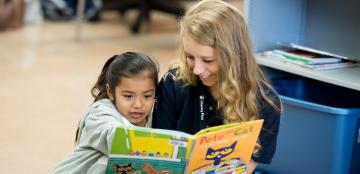
Learning to Read; Reading to Learn
“I can read!”
That’s the moment we at Literacy First live for. We are boundlessly proud of every child who learns to read.
For more than 20 years, Literacy First, a program of the Charles A. Dana Center, has been providing one-to-one early literacy tutoring to children in Central Texas elementary schools.
Why does a literacy tutoring center live at the Dana Center, widely known for its work in mathematics and science education from kindergarten through college?
Because reading is a gateway to all other learning.
A child who can read is far more likely to succeed in mathematics and science as well. The Dana Center recognized and acted on this insight back in 1994, when Dana Center director Uri Treisman worked with Gay Su Pinnell and others to launch Literacy First (originally named AmeriCorps for Math and Literacy).
Struggling to Read
The correlations between low literacy and impoverished lives have been well-documented.
Americans who cannot read, or who struggle to read (known as “low literacy”) generally do less well in school (and usually do not go on to college), experience more unemployment or dead-end low-wage jobs, suffer higher poverty and incarceration rates, and struggle with simple tasks of daily living, such as reading road signs and prescription bottles, not to mention loan applications and voter registration forms.
While students from all income levels can struggle with learning to read, research shows that children from higher-income families tend to have better experiences than children from lower-income families.
Children in middle- and higher-income families, compared to children from lower-income families:
- Are more likely to access quality early childhood experiences that build a foundation for success in learning to read.
- Are prepared to meet rigorous early reading curriculum when they start kindergarten.
- Have mastered the fundamental reading skills, and their reading takes off by the end of first grade.
- Are more likely to read outside of school, which helps them learn more new vocabulary words and strengthen comprehension skills, which then increases their reading success.
This snowballing, cumulative impact of strong early reading skills is well documented.
What happens for students from lower-income families who start school with limited access to the same experiences and early education in their first five years? They are playing catch-up from day 1. This literacy gap is smaller in kindergarten, but by the end of first grade the gap widens.
Closing the Gap
It turns out that there is a relatively small window of opportunity to close the reading gap. If left unaddressed for too long, the gap becomes almost unbridgeable, especially for students living in poverty.
First-grade reading achievement predicts future achievement with alarming accuracy, and if students do not read well by third grade, they are four times more likely to not graduate high school.
This issue is critical in Central Texas, where 1 in 4 children live in poverty. Almost 60 percent of the kindergartners in our region are already falling behind in learning to read when they begin school.
It is essential that we help students catch up their reading skills in the early grades so they can take full advantage of classroom instruction.
And the research is clear. When we invest resources to ensure children learn to read well in the early grades, they can then read to learn.
At Literacy First, this is what we are passionate about. For more than twenty years, we have been driven by the goal of ensuring all children read well by third grade.
Each year, at least 75 percent of the students in our program demonstrate accelerated progress to grade level in critical reading skills. As a result, we are moving the needle on reading achievement. Two rigorous external evaluations (available upon request) have shown that students served by Literacy First outperformed a comparison group, and that these gains were still evident two years later, including higher passing rates on the third-grade state reading assessment.
Learning to Read
Three factors are central to this success.
- Tutoring is intensive. Each child receives one-to-one, individualized instruction daily for 20-30 minutes.
- Our tutors are highly trained. They receive more than 50 hours of literacy training during the year, and Literacy First staff are on-site weekly to provide ongoing support and supervision throughout the year.
- The instruction is data-driven. Tutors assess and graph students’ progress weekly, and this real-time data is used to individualize instructional decisions for each student. Even after students graduate from the program, we continue to monitor their progress to ensure that gains in reading are maintained.
Early intervention not only prevents future reading and learning difficulties; it helps districts allocate their resources efficiently. One principal shared that in the first year that Literacy First served her campus, the number of students who were retained in kindergarten through grade 2 dropped by 75%.
Literacy First also serves as an “early warning bell” to identify those students (less than 10%) who do not respond well to the Literacy First interventions and are in need of more intensive support. This is valuable information for school staff in planning the most appropriate services for each student.
Knowing that the best outcomes emerge from collaborative relationships, we work with local partners including Austin ISD, Pflugerville ISD, and Wayside Schools, and 90 full-time tutors, who work with more than 1800 students in 26 Central Texas elementary schools.
This work demonstrates that evidence-based community–school partnerships can help close reading achievement gaps—and do so cost-effectively.
Reading to Learn
Since 1994, we’ve helped more than 20,000 young students learn to read. We regularly share their stories over at the Literacy First blog.
About Literacy First
Literacy First is an effective public–private partnership that helps very young children learn to read. A program of the Charles A. Dana Center at The University of Texas at Austin, Literacy First works with AmeriCorps, local school districts, and community stakeholders, to deliver an effective, evidence-based program that significantly improves reading outcomes for kindergarten through second grade students in Title I schools in Central Texas.
About the Author
Mary Ellen Isaacs
As a proud and passionate reading educator, I know that literacy, more than any other skill, can change the trajectory of a life. I love teaching children to read and watching the world open up to them in new ways. I am grateful to work with amazing colleagues, AmeriCorps tutors, school partners, and community supporters who believe all our children have a right to become fully literate.
Get in Touch
How can the Dana Center work with you to ensure that our nation's students are ready for postsecondary education and the contemporary workforce?

